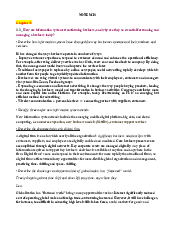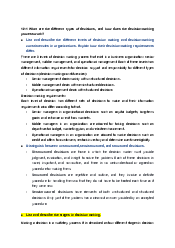


Preview text:
Chapter 3 – Case Study
Title: “Digital Technology Helps Crayola Brighten Its Brand” Group Members
Nguyen Kim Ngan – BAFNIU21216
Nguyen Bich Ngoc – BAFNIU21329
Tran Vo Duy Khang – BAFNIU21457 Question Answer Analyze Crayola’s problem.
Management: As computers and web-based What management,
learning grow more prevalent, children are organization, and
abandoning handheld art that is offered to them technology factors
at an earlier age. Children start to prefer contributed to the problem?
electronics over toys and crayons when they are
four or five years old, when they are old enough to play on a computer.
Organization: Crayola crayons face competition
not from comparable items, but from changes throughout time.
Technology: Crayola crayons are competing
with technology; therefore, the world of
children's games is now seeing a shift to digital
items that replace physical products. What competitive strategies
The corporation has changed its focus from is Crayola pursuing? How
concentrating on particular product lines to does digital technology
focusing on consumer insights and demands. support those strategies?
The goal of Crayola has always been to promote
originality and help teachers and parents develop
imaginative and creative children. The
company's main goal is to encourage kids to play
in color. Crayola revised its business strategy,
put a new product creation process in place, and
created new products and streams of income.
Crayola has started to "hybridize the old with the
new," or combine traditional products with
innovative technology. For example, they
upgraded their crayons with technology and
created the iMarker, an all-in-one digital pen.
The business changed from producing crayons
and painting supplies to becoming a dependable
supplier of resources and opportunities for imaginative play. What people issues did
The people issue Crayola had to address were Crayola have to address in
that the parents were looking for toys that are designing its new
less messy than the traditional marker and technology-based products?
fingerpaints. The product should also increase
the creativity of the children and should be easy
for the children to use. Crayola's latest digital
toys are "100% mess-proof," and technology has
assisted the firm in making its other goods less
messy. The corporation is aware of how digital
technology might affect people of various ages.
For example: The My First Crayola line is
targeted specifically at one-year-olds while
Crayola Catwalk Creations is designed for
tweens (9-12 years) girls who like expressing themselves through fashion. How has digital technology
The marketing plan for Crayola has been changed Crayola’s business
modified, and internet marketing is now model and the way it runs
receiving more concentration. Through social its business?
media pushes, online advertising, promotions,
and other digital activation activities, Crayola
communicates with parents and educators. The
way Crayola markets its products has changed,
and it has been increasing its expenditure on
digital advertising. Crayola has enjoyed more
accelerated growth due to its new portfolio of goods and services.




